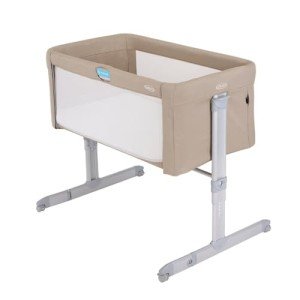The Benefits and Considerations of Bedside Cots for Co-Sleeping
Co-sleeping has actually emerged as a popular choice for lots of new parents who seek to maintain close proximity to their infants throughout the night. Together with conventional co-sleeping practices, bedside cots are getting traction as an option that offers both the convenience of nearness and the security of different sleeping spaces. This article intends to explore the concept of bedside cots for co-sleeping, highlighting their advantages, prospective disadvantages, suggestions for choice, and typical issues.
Comprehending Bedside Cots
Bedside cots, also referred to as side-sleepers or co-sleepers, are specifically designed cribs that are affixed to the side of the parents' bed. They permit parents to preserve easy access to their infants in the evening while offering a different sleeping area that can improve safety and convenience.
Functions of Bedside Cots
- Size and Design: Bedside cots are often smaller sized than standard cribs however still offer ample room for an infant. Many models have adjustable heights to match the bed.
- Side Panels: Many models include removable or mesh side panels that enable for safe visual tracking of the baby, enhancing parents' ability to react to their baby's needs rapidly.
- Stability and Safety: Bedside cots are developed with stability in mind, featuring security anchors or straps that protect the cot to the parent's bed.
- Relieve of Access: Parents can easily reach over to comfort or feed their baby without having to get out of bed, assisting in nighttime breastfeeding or relaxing.
Advantages of Using Bedside Cots for Co-Sleeping
- Enhanced Bonding: Proximity to the baby cultivates psychological connection and bonding, which is crucial during the early stages of development.
- Easier Nighttime Care: Nighttime feeding and soothing ended up being significantly easier with a bedside cot, as parents can just lean over to participate in to their baby's requirements.
- Increased Safety: Bedside cots minimize the threat of suffocation or accidental rolls that can accompany standard co-sleeping directly in the parental bed.
- Private Sleep Space: The documentation supports that having their own sleeping space can assist infants sleep better in regards to fewer disruptions from parents.
- Transitioning: A bedside cot can be a useful transitional tool as babies grow and start to move to their own spaces.
| Function | Advantages |
|---|---|
| Enhanced Bonding | Closer physical existence |
| Easier Access | Quick response to requirements |
| Increased Safety | Minimized threat of mishaps |
| Specific Space | Less disturbance during the night |
| Streamlined Transition | Simpler transfer to independent sleeping |
Factors to consider Before Choosing a Bedside Cot
While bedside cots provide many benefits, possible users should think about the list below aspects:
- Size of Bed: Ensure that the cot fits adjacent to the bed without triggering pain or overcrowding.
- Budget plan: Prices can differ significantly among various brand names and models, so think about budget plan constraints thoroughly.
- Safety Standards: Check that the cot satisfies all security regulations to ensure it is free from harmful materials and consists of required safety features.
- Material: Non-toxic finishes and products are most importantly essential for infant health.
- Infant's Age and Weight: Some cots have weight limits, and parents should choose accordingly based on their baby's growth.
Tips for Selecting a Bedside Cot
- Check out Reviews: Look for user feedback and security rankings.
- Inspect for Certifications: Ensure the cot complies with security requirements.
- Check the Design: Choose a design that matches your bed room design while ensuring functionality.
- Consider Accessibility: Look for designs that enable easy reach but lessen the threat of presenting.
- Test Stability: Ensure that the cot is stable and safe and secure when attached to the bed.
Common FAQs About Bedside Cots for Co-Sleeping
Q1: Are bedside cots safe for co-sleeping?
A1: When utilized correctly, bedside cots are developed to supply a safe sleeping alternative for infants while making it possible for close distance to parents. Constantly ensure to protect Bedside Cot For Comfortable Sleep to prevent movements that could cause accidents.
Q2: At what age can I begin utilizing a bedside cot?A2: Many parents start using bedside cots right after the baby is born. Nevertheless, it is vital to consult with a health care company concerning your infant's readiness for co-sleeping, especially if they were born prematurely. Q3: Can I use a regular
crib for co-sleeping? A3: While routine cribs can be utilized, they do not provide the same level of availability and security as bedside cots, making bedside choices more favorable for co-sleeping. Q4: What if my baby rolls over?A4: Most bedside cots are designed with safety functions that decrease threats if a baby rolls. Furthermore,
they are normally low enough that a roll would not lead to a considerable drop. Q5: How do I transition my baby from a bedside cot to a regular crib?A5: Gradually move your baby to a different crib in their own room after they become accustomed to oversleeping the bedside cot. Start with naps in the crib while keeping nighttime co-sleeping until they adjust. Bedside Cot For Safe Sleeping provide a practical and more secure alternative to direct co-sleeping, supplying numerous benefits in regards to benefit and security. They assist in bonding
in between infants and parents while minimizing the dangers connected with standard co-sleeping practices. Parents trying to find a method to keep their babies close during the night should think about the benefits that bedside cots can use. With a mindful examination of choices available, parents can develop a safe and comfortable sleep environment that supports their household's distinct needs.

